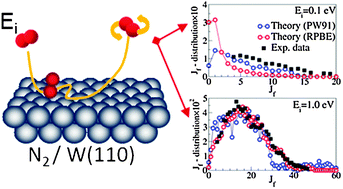The non-reactive scattering of N2 from the W(110) surface is studied with six dimensional (6D) classical dynamics and two distinct potential energy surfaces (PES). Here, we use the PESs calculated with density functional theory and two different exchange–correlation functionals, the PW91 [J. E. Perdew et al., Phys. Rev. B, 1992, 46, 6671] and the RPBE [B. Hammer et al., Phys. Rev. B, 1999, 59, 7413]. By analyzing the final rotational state and angular distributions, we extract information on the characteristics of the two PESs in the 6D configurational space. Comparison of the theoretical results with the available experimental data provides detailed information on the validity of each functional. In general, the PW91 PES is more corrugated than the RPBE one in all the configurational space, meaning that there is a stronger dependence of the potential energy on the molecular orientation and position over the surface unit cell. Furthermore, we find that the larger corrugation and the less repulsive character exhibited by the PW91 PES seems to be realistic at distances above the chemisorption well. In contrast, the less corrugated RPBE PES performs better in the region below the chemisorption well.

You have access to this article
 Please wait while we load your content...
Something went wrong. Try again?
Please wait while we load your content...
Something went wrong. Try again?


 Please wait while we load your content...
Please wait while we load your content...